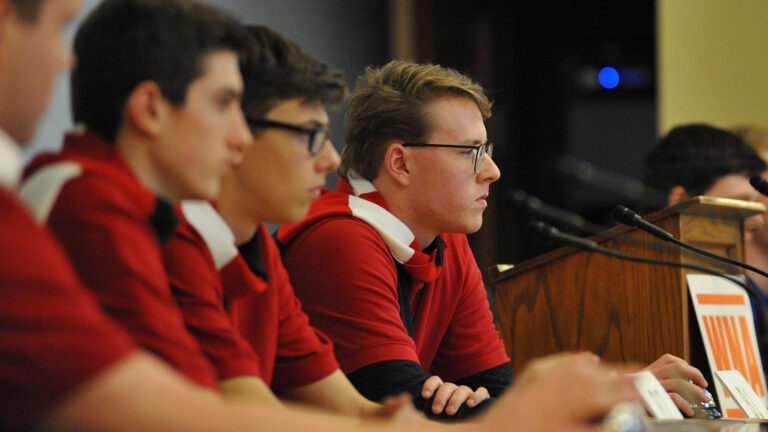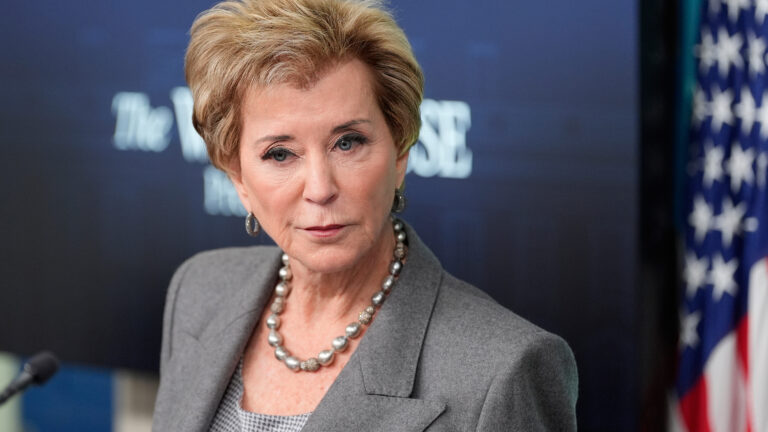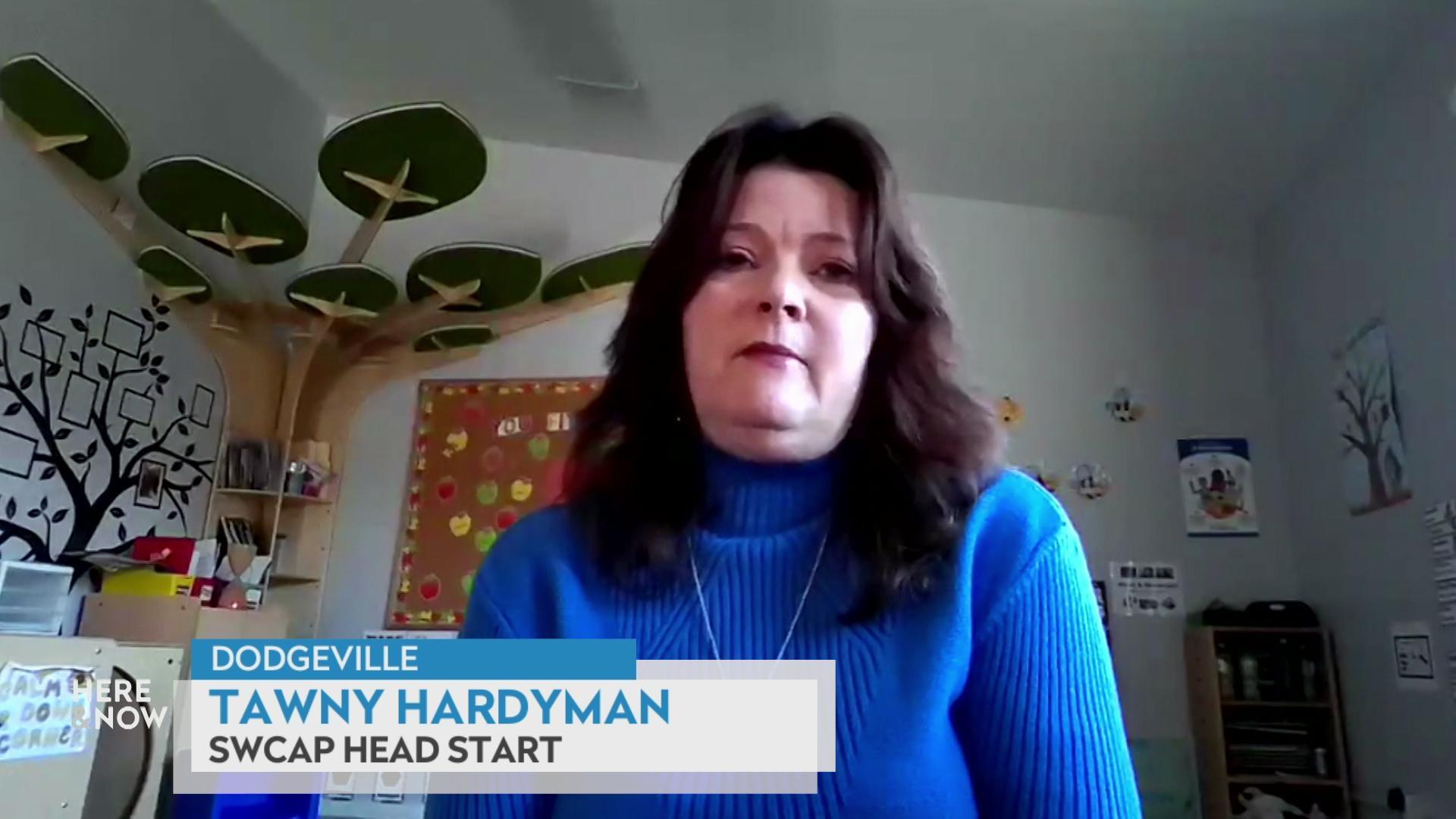A surge in book challenges has Wisconsin school districts scrambling to keep pace
An attempt to ban over 400 books in Elkhorn schools left administrators pondering different approaches to assessing titles listed in challenges, while school librarians point to current book review and recommendation systems as effective.
By Nathan Denzin | Here & Now
May 15, 2024

Books fill shelves at the Elkhorn Area High School library on March 21, 2024. The Elkhorn Area School District received a challenge to more than 400 books in December 2023, which required administrators to consult reviews and other resources to assess the basis of challenges to specific titles. (Credit: PBS Wisconsin)
Jason Tadlock, superintendent of the Elkhorn Area School District, had his hands full with a book challenge that went after 444 library titles in December 2023.
To review a challenge, educators and school staff find and assess professional reviews of each book. Professional reviews can include age and grade recommendations, as well as warnings about any sensitive topics covered.
But when Tadlock’s first online search of such reviews and in consultation with Wisconsin-based organizations brought back just 120 results, it left him wondering why there is no consistent book rating system.
“I could go to anyone and say there are PG, PG-13, R and NC-17 movies — and the general public would have a great idea of what that movie would be like,” Tadlock said. “That system is lacking within print.”
This process wasn’t always a time-confusing issue for educators, but attempts to ban books are on the rise in Wisconsin. According to the American Library Association, the number of titles challenged hit record highs in 2022 and 2023 at a nationwide level. In 2023, Wisconsin saw 27 challenges aimed at 448 books.
Ten years earlier, a typical challenge would likely have been over a single book that a concerned parent brought to a librarian or educator. Tadlock said when a school or district only has to check a couple of books, there isn’t an interest in a more standardized rating system.
“A couple of years ago, we did have a book challenge related to two books that were located at the middle school,” he said. “[The books] were not even in the middle school library, but a middle school book collection for the eighth-grade level, so we could read them.”
In contrast, more recent challenges include long lists of books that have been sent straight to district administrators or school boards, like the one in Elkhorn.
“There were so many books incorporated in that challenge that it made teachers uncomfortable even giving access to their [class] collection because they didn’t have the time to go through and check,” Tadlock explained.
With the initial 120 professional reviews, Tadlock and the principal of Elkhorn Area Middle School were able to work through those challenged books fairly quickly. But the process to find reviews for the other 300, which were primarily in the district high school’s library, was much more difficult.
“There’s so much gray in this process because there’s nothing that was black and white about [the books],” said Dan Kiel, principal of Elkhorn Area High School. “You know, even if one system said the book was one level, a different system said it was another.”
In all, Tadlock and Kiel estimate it took about two months to finish working through the challenge list. Ultimately, none of the books were banned, because staff did not find any of the books to be objectionable. A handful of books were moved from the middle to high school, and another handful had a grade or age restriction applied.
Part of the difficulty comes from the way books are classified. Generally, there are six broad categories a book can fall into upon release: Children’s fiction and non-fiction, Young Adult fiction and non-fiction, and Adult fiction and non-fiction.
“[The classification] has nothing to do with the nature of what’s in the book, it has to do with who is the target audience,” said Tadlock.
A book can be categorized as Young Adult but still have themes related to matters like sex or drug abuse, while a cookbook would be categorized as Adult because it is targeted toward home chefs, who are typically adults.
“The system is broken, it’s not great in the level of clarity that it provides to [librarians] in regards to the age appropriateness of the book,” Tadlock said.
However, officials from the Wisconsin Department of Public Instruction say the concept of a rating system for books similar to television, film or video games is a near impossible task. Monica Treptow, the school library media consultant with Wisconsin DPI said that because movies generate much more revenue per-unit than books do, there simply isn’t the cash.
“I don’t see [movie-like ratings] as being a feasible option,” she said.
While the movie industry in America earns less money overall than the book publishing industry — $11.9 billion from box office revenues in 2019 versus $28 billion in book sale revenues for 2022 — there are far more books published in a year than movies released. Outside of traditional box office sales, the movie industry as a whole took in about $93 billion in 2022 — which includes streaming, physical media sales, TV revenue and more, eclipsing annual book revenue.
In 2019, around 500 films were released in theaters in the United States, while there are hundreds of thousands of books published annually. Penguin Random House, one of the largest publishing houses in the country, has been found to publish about 85,000 titles each year.
“All of the professional reviews done by librarians and by professionals do provide age level recommendations, grade level recommendations, reading level recommendations,” Treptow said. “I go back to this being a professional process, the curation of a library.”
While they don’t have a rating system like those for screen-based media, librarians have organizations like the Cooperative Children’s Book Center at the University of Wisconsin-Madison to help with these decisions. The center provides lists of recommended books, professional reviews and has staff on-hand to help librarians with book challenges.
“I work very closely with the [CCBC], as they are a key resource to provide materials about specific books, reviews and such to help a librarian navigate a challenge,” Treptow continued. “In addition to that individual consultation, we’ve done numerous webinars, workshops, conference presentations with the CCBC.”
The center also maintains a forum for librarians to get advice on topics related to book challenges.
“I would argue that there is a type of rating system already in place, it just looks very different from what we consider a movie rating system,” Treptow said. “It is a process.”
Editor’s note: This article is updated to provide more detail about revenue sources of the movie industry.
 Passport
Passport











Follow Us